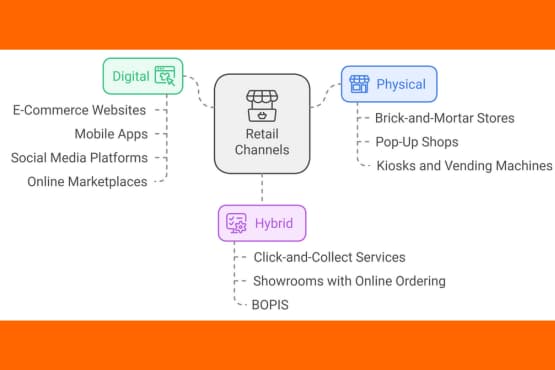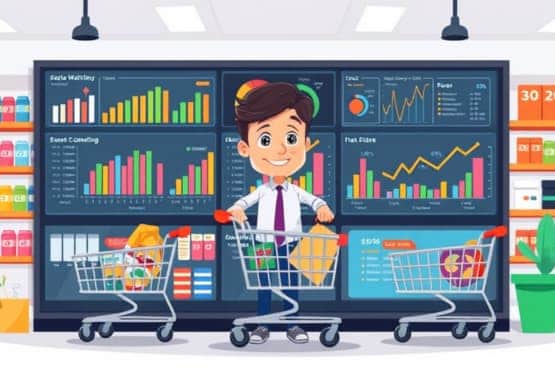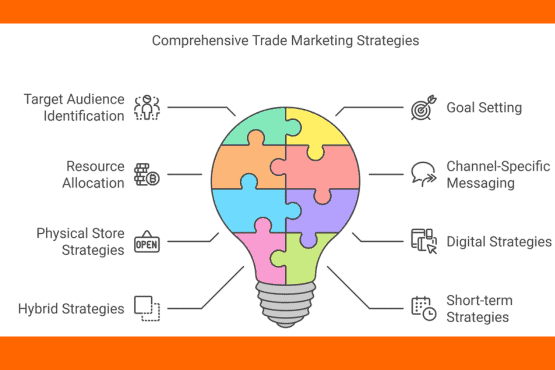Businesses must navigate a complex network of retail channels to reach customers effectively. These channels represent how products or services move from companies to consumers or other businesses.
Definition and Scope
Retail channels encompass business-to-consumer (B2C) and business-to-business (B2B) contexts. They include:
- Physical locations (stores, showrooms)
- Digital platforms (websites, apps, marketplaces)
- Hybrid models (click-and-collect, showrooming)
Importance in Trade Marketing
Understanding these channels is critical for modern trade marketing strategies:
- Changing consumer behaviour: Shoppers now expect seamless experiences across multiple touchpoints.
- Technological advancements: New tools enable more targeted and efficient marketing approaches.
- Competitive advantage: Effective use of various channels can set businesses apart in crowded markets.

Historical Context
The retail landscape has undergone significant shifts:
- 1990s-2000s: Rise of e-commerce platforms
- 2010s: Mobile shopping boom and social commerce emergence
- 2020s: Acceleration of digital transformation due to global events
These changes highlight the need for businesses to adapt and diversify their channel strategies continually.
2. Types of Retail Channels

Physical (Traditional)
Physical retail channels include:
- Brick-and-mortar stores serve as a crucial distribution channel in the retail landscape.
- Pop-up shops
- Kiosks and vending machines
These channels offer tangible experiences and immediate gratification for customers.
Digital
Digital retail channels encompass:
- E-commerce websites
- Mobile apps can act as intermediaries in the distribution channel, enhancing customer engagement.
- Social media platforms (Facebook Shops, Instagram Shopping)
- Online marketplaces (Amazon, Etsy)
These platforms provide convenience, a vast selection, and 24/7 accessibility.
Hybrid
Hybrid models blend physical and digital experiences, seamlessly integrating direct and indirect distribution.
- Click-and-collect services
- Showrooms with online ordering
- Buy Online, Pick Up In Store (BOPIS)
These approaches cater to customers who value online convenience and physical product interaction.
Channel Impact on Consumer Behavior
Different channels influence buying decisions in unique ways:
- Physical stores enable sensory experiences and immediate purchases
- Digital platforms facilitate research and comparison shopping
- Hybrid models offer flexibility and reduce perceived risk in online shopping
Understanding these influences is crucial for crafting effective trade marketing strategies within direct and indirect distribution frameworks.
3. Pros and Cons of Each Channel
| Channel Type | Advantages | Disadvantages |
|---|---|---|
| Traditional Channels | Tactile product experiences | Technical issues can disrupt sales. |
| Immediate gratification | Higher overhead costs | |
| Personal customer service | Inventory management challenges | |
| Building local community connections | Limited operating hours | |
| Digital Channels | Global reach | Lack of physical product interaction |
| 24/7 availability | Shipping and return complexities | |
| Lower operational costs | Cybersecurity concerns | |
| Easy performance tracking | Managing indirect distribution can be complex. | |
| Personalization capabilities | ||
| Hybrid Models | Advantages: | Disadvantages: |
| Combines benefits of physical and digital | Requires seamless system integration | |
| Enhances customer convenience | Initial setup costs can be high. | |
| Improves inventory management | Initial setup costs can be high |
Influence on Marketing Success
Each channel type affects overall marketing success differently:
- Physical stores excel at creating memorable brand experiences and building customer loyalty
- Digital platforms offer unparalleled reach and data collection capabilities
- Hybrid models can enhance brand visibility and cater to diverse customer preferences
Research shows that companies implementing omnichannel strategies see a 9.5% year-over-year increase in annual revenue, compared to 3.4% for those that don’t.
Customers who engage with brands across multiple channels spend 10% more online and 4% more in-store than single-channel customers.
Trade Marketing in the Context of Retail Channels
Trade marketing is crucial in optimizing the performance of various retail channels. It focuses on marketing strategies and tactics to increase demand among supply chain partners, such as distributors, wholesalers, and retailers.
Key Concepts in Trade Marketing
- Channel Management: Developing strategies to manage relationships with different channel partners effectively.
- Trade Promotions: Creating promotional activities for trade partners to boost sales and visibility.
- Category Management: Collaborating with retailers to optimize product categories for maximum profitability.
- Point of Sale Marketing: Designing effective in-store displays and promotional materials.

Relationship Between Trade Marketing & Retail Channels
Different retail channels require tailored trade marketing approaches:
- Physical Stores: Focus on in-store promotions, product placement, and staff training.
- E-commerce: Emphasize digital shelf optimization, online promotions, and content marketing.
- Hybrid Models: Develop integrated strategies that bridge online and offline experiences.
4. Retail Channel Analysis
Key Performance Indicators (KPIs)
Effective analysis relies on tracking specific KPIs for each channel type:
Physical Stores: are essential for direct distribution, allowing customers to interact with products firsthand.
- Foot traffic
- Sales per square foot
- Average transaction value
- Conversion rate (visitors to buyers)
Digital Platforms:
- Website Traffic
- Click-through rates
- Cart abandonment rate
- Customer acquisition cost
Hybrid Models:
- Cross-channel conversion rates
- Return on investment for each touchpoint
- Customer lifetime value across channels

Market Trends and Consumer Behavior
Current trends shaping retail channels include the rise of direct distribution through e-commerce and the increasing importance of intermediaries.
- Increased demand for personalized experiences
- Growing importance of mobile commerce
- Rise of voice shopping and smart home devices
- Emphasis on sustainable and ethical business practices

Tools for Channel Analysis
Businesses can leverage various tools to analyze performance:
- Google Analytics for website and e-commerce tracking
- Foot traffic counters and heat mapping for physical stores
- Customer relationship management (CRM) systems for cross-channel insights
- Social media analytics tools for tracking engagement and conversions
Actionable Examples
Case Study: Walmart’s Data Analytics
Walmart uses advanced analytics to optimize its multichannel strategy, focusing on direct and indirect distribution methods.
By analyzing customer data across online and offline touchpoints, Walmart has improved inventory management, personalized marketing efforts, and overall customer satisfaction.
Metrics for Measuring Trade Marketing Success
When evaluating trade marketing effectiveness across different channels, consider these KPIs:

- Return on Trade Spend (ROTS): Measures the revenue generated relative to trade marketing investments.
- Incremental Sales Lift: Quantifies additional sales generated by specific trade marketing activities.
- Share of Shelf: Tracks the percentage of shelf space occupied by a brand’s products in physical stores or digital marketplaces.
- Trade Partner Satisfaction Score: Measures the satisfaction level of channel partners with trade marketing initiatives.
- Promotional Compliance Rate: Monitors the percentage of trade partners adhering to agreed promotional activities.
- Category Captain Metrics: For businesses in category management roles, track metrics like category growth rate and market share.
- Digital Share of Voice: Measures the brand’s visibility and prominence in online retail channels.
By focusing on these metrics, businesses can more accurately assess and optimize their trade marketing strategies across various retail channels.
Tools for Trade Marketing Optimization

- Trade Promotion Management (TPM) Software: Tools like Blacksmith Applications or Acumen TPM help manage and optimize trade promotions across channels.
- Retail Execution Platforms: Solutions like Repsly or StayinFront enable field teams to monitor and improve the in-store execution of trade marketing initiatives.
- Price Optimization Tools: Platforms like Competera or Price f(x) help determine optimal pricing strategies across different channels.
- Assortment Planning Software: Tools like JDA Software or O9 Solutions assist in optimizing product assortments for different retail channels.
- Digital Shelf Analytics: Solutions like Profitero or DataWeave provide insights into online product performance and visibility.
5. Trade Marketing Channel Strategy
Defining Trade Marketing Strategies
Creating effective strategies involves:
- Identifying target audiences for each channel
- Setting clear goals and objectives
- Allocating resources appropriately
- Developing channel-specific messaging and promotions

Aligning Strategies with Channel Types
Considerations for different channels:
Physical stores play a vital role in the direct distribution of products to consumers.
- Focus on experiential marketing and excellent customer service
- Optimize store layouts and product displays
Digital:
- Invest in user-friendly websites and mobile apps
- Implement robust digital marketing campaigns
Hybrid:
- Businesses must consider direct and indirect distribution methods to ensure seamless integration between online and offline experiences.
- Train staff to handle cross-channel interactions
Case Studies of Successful Strategies
- Sephora’s “Beauty Insider” Program: Sephora’s loyalty program integrates online and in-store experiences, driving customer engagement across all retail channels.
- Nike’s Direct-to-Consumer Approach: Nike has successfully shifted towards a direct-to-consumer model, blending physical stores, e-commerce, and mobile apps to create a cohesive brand experience.
Short-term vs. Long-term Strategies
Short-term strategies might include:
- Seasonal promotions across channels
- Limited-time offers to drive traffic to specific channels
Long-term strategies could involve:
- Investing in technology infrastructure for better cross-channel integration
- Developing a robust customer data platform for personalized marketing
Optimization Techniques for Trade Marketing Strategies
Case Study: Procter & Gamble’s Channel-Specific Approach
Procter & Gamble (P&G) optimized its trade marketing strategy by tailoring its approach to different retail channels:
- Physical Stores: Implemented “store-back” design thinking, creating packaging and displays optimized for in-store visibility and ease of restocking.
- E-commerce: Developed “e-commerce-friendly” packaging designs and invested in enhanced product content for online platforms.
- Hybrid: Created QR code-enabled in-store displays that link to online content, bridging the physical and digital experience.
Results: P&G saw a 5% increase in sales across channels and improved relationships with retail partners.
Example: Coca-Cola’s Data-Driven Optimization
Coca-Cola used retail channel analysis to optimize its trade marketing:
- Analyzed point-of-sale data across different channels to identify sales patterns.
- Used insights to tailor product mix and promotional strategies for each channel type.
- Implemented dynamic pricing strategies based on channel-specific demand patterns.
Outcome: 3% increase in overall sales and 7% improvement in trade partner satisfaction scores.
6. Multi-Channel Strategies
Importance of Integration Across Channels
Providing a seamless customer experience across all touchpoints is crucial. Research indicates that retailers using three or more channels can experience a 287% increase in purchase rates compared to single-channel campaigns.

Best Practices for Multi-channel Marketing
- Maintain consistent branding and messaging across all channels
- Implement unified customer service across channels
- Offer flexible fulfillment options (e.g., buy online, return in-store)
- Use data from all channels to inform the overall strategy
Measuring Effectiveness Across Channels
Tools for monitoring cross-channel performance include:
- CRM systems for tracking customer interactions
- Attribution modeling to understand the impact of each touchpoint
- Customer journey mapping to identify pain points and opportunities
Potential Pitfalls
Common challenges in multi-channel approaches:
- Siloed data leading to inconsistent customer experiences can hinder effective distribution channel strategies.
- Inventory discrepancies between online and offline channels
- Difficulty in accurately attributing sales to specific channels
7. Emerging Trends in Retail Channels
Impact of E-commerce on Traditional Retail
Physical stores are evolving into experience centers, complementing online sales. For example, Nordstrom has opened inventory-free showrooms where customers can try on clothes and place orders for home delivery.

Role of Data Analytics in Channel Strategy
Brands are increasingly using big data to:
- Personalize customer experiences
- Optimize pricing and promotions
- Predict demand and manage inventory
Customer Experience Across Channels
Technologies reshaping the customer journey include:
- Augmented Reality (AR) for virtual try-ons enhances the customer experience in direct and indirect distribution settings.
- Artificial Intelligence (AI) for personalized recommendations
- Machine Learning for predictive analytics
Case Study: IKEA’s AR Application IKEA’s AR app allows customers to place furniture in their homes virtually before purchasing, blending digital innovation with their traditional showroom model.
Additional Emerging Trends
- Social commerce on platforms like Instagram and TikTok
- Subscription models for regular, recurring purchases can be effective in direct and indirect distribution channels.
- AI-powered chatbots for customer service
- Growing focus on sustainable and ethical retail practices
8. Conclusion
Understanding and effectively leveraging various retail channels is crucial for business success in today’s diverse market. Each channel offers unique benefits and challenges, and successful businesses often employ various approaches to reach their customers effectively.
By embracing a data-driven, customer-centric approach to retail channel management, businesses can enhance their market presence, improve customer engagement, and drive sustainable growth.
To effectively enhance your trade marketing efforts, consider diving into additional insights and strategies available at TRADE MARKETING INSIDER, where a wealth of resources awaits to support your journey.




